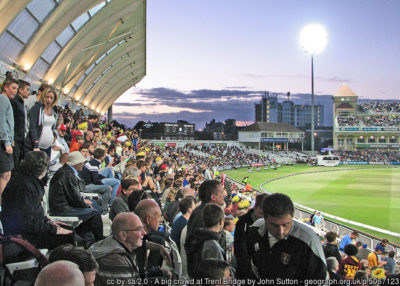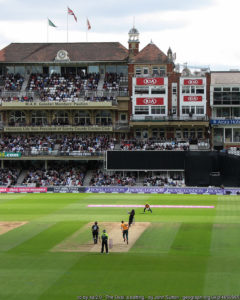As the 2019 cricket season begins, ABC Chairman Peter Boyce reflects on the challenges – and the opportunities – for county cricket.
Cricket is the only mass spectator sport which is based upon our historic counties. Total attendance figures for county cricket in 2018 were around the 1.7 million mark. This puts it behind only Rugby union (just) and football (by a mile) as the most popular spectator sport in England and Wales. And yet the England and Wales Cricket Board seems determined to undermine it and, many suspect, work towards its ultimate demise. The county clubs and county cricket fans need to act now – before the heart is ripped out of our national summer sport and we lose a huge part of our county heritage.
The supposedly parlous state of county cricket is one of the favourite subjects for lazy ex-pro media pundits needing something to fill up their column inches, airtime or Twitter feed. Whilst there is unquestionably much that could be improved, it is also clear that there is still huge public support for the basing of domestic cricket on the counties. The attendance figures for county cricket actually suggest it is very healthy. T20 cricket is positively thriving.
Total attendance figures for the first-class County Championship in 2018 were around 600,000. Despite the stereotypical image of a Championship crowd comprising one man and his dog, these numbers are similar to what they were 30 years ago. They have risen significantly from a low point of less than 500,000 around the turn of the century. The 50-over Royal London One Day Cup fared less well in 2018 with a total attendance of around 180,000. The final at Lords attracted a crowd of more than 20,000.
But the big crowd puller is the 20-over T20 Blast which set a new attendance record of 931,000 in 2018. The finals day at Edgbaston was sold out before the competition even began and is now firmly established as one of the highlights of the summer sporting calendar, being not just a day of enthralling cricket but one huge party. These attendance figures compare favourably with the Indian Premier League which had a total attendance of 1.7 million in 2018, admittedly over a smaller number of games. Cricket is the number one sport in India, a national obsession. For the T20 Blast to be pulling more than half the same aggregate attendance as the IPL shows what a strongly supported competition it is – and what huge further potential it has if properly managed and promoted.

One might think the England and Wales Cricket Board would be looking for ways to build on the strength of its county cricket. Instead, the Board appears to have set themselves against it. From 2020 the Board intends to introduce a new domestic competition dubbed “The Hundred”. The Board aims to emulate the money made by the IPL and the Australian Big Bash by filling the large test-match grounds and selling the TV rights.
The new competition is radical in several ways. First, it is to comprise 100 balls per innings, bowled in blocks of 10 from each end. Second, it is not to be based on the county sides but around 8 newly created teams – based at the 8 test match venues. These teams are (for now) only to exist for the new tournament. There is no news yet on their names or whether are meant to represent a city or a region or what exactly. The competition will be played from late July into August. The plan to introduce yet another format of cricket – and one so contrived and removed from the traditional game – has been widely criticised, not to say ridiculed. Writing in the Guardian Matthew Engel said “The new event is riddled with obvious flaws. Either the marketing money being hurled at it will buy short-term success, leading to the permanent enfeeblement of all other domestic cricket. Or it will be a very, very expensive fiasco.”
For ABC, of course, the main problem is the effect this new competition may have on county cricket. In the short-term this may not be too bad. The T20 Blast will continue in its current format, although moved to June-July. This actually gives it two advantages over The Hundred – the weather is usually better at that time of year and this slot also coincides with the few weeks of the year there is no football. The T20 format is also that which the big leagues throughout the world use and the fact that this will remain the preserve of the counties in England and Wales is a big plus.
Ex-England captain Michael Vaughan is always a strong advocate for city-based teams for short-form cricket (though paradoxically a keen Yorkshire supporter). On Five Live he recently expressed the view that traditional county cricket fans may rally around the T20 Blast leaving the new The Hundred competition to be supported by a new, younger, family-based audience. To what extent this happens remains to be seen. The Board’s attempt to devise a whole new format seems more designed to confuse than to draw people in. Also, the T20 Blast will inevitably remain the better attended competition. Even if every game of The Hundred is a sell-out, it will still only have a total attendance half that of T20 Blast. So, the T20 Blast will certainly continue to be a big crowd pleaser and money spinner for the time being.
However, the launch of the new competition will also have an effect on the County Championship and the Royal London One Day Cup. The county club sides will complete in the Royal London One Day Cup at the same time that The Hundred is going on, the idea being that the top domestic players will play in The Hundred giving opportunities for younger players in the county competition. The County Championship will be increasingly pushed to the opening weeks (April and May) and closing weeks (September) of the season with little Championship cricket at all from June-August. The Championship is always portrayed as the premier domestic competition and the training ground for test cricketers. You can draw your own conclusions as to what the Board really thinks of it.

For ABC the bottom line is this. The county cricket clubs represent communities. They have a history, a heritage and an existing support base build up over many generations. Attendance figures for domestic cricket in England and Wales are already strong in comparison to Australia and Indian (in both of which cricket is the most popular sport). So yes, let’s have serious marketing. Yes, let’s have terrestrial TV coverage. Yes, let’s have big international stars. Yes, let’s get the stars of the England team playing. But, let’s do all of this in a county-based competition. Let’s build on the success of the T20 Blast and take it to the next level.
But let’s not just be happy with that. It’s time to look at the whole structure of domestic cricket. There are many things which could be done to further build its support base. Some years ago (2005) David Paton and Andrew Cooke of Nottingham University analysed the factors which affect domestic cricket attendances. Many of their findings are just common sense but they were backed up by the statistics.
First, attendances at county games are higher when the games do not clash with an international match. Related to this is the finding that when centrally contracted England players play in county cricket, it has a big impact on attendances. If the T20 Blast was seen as a premium competition during which no international matches were scheduled and all England players were available for all matches, this would a massive boost to its status and appeal.
Second, floodlit and evening matches have higher attendance figures. This has long been the case for one-day cricket but recently there was an experiment in day/night Championship cricket. However, throughout much of the summer cricket could continue to 8pm or even later without the need for floodlighting. Cricket grounds should be places where people can go after work to relax, socialise and enjoy some cricket.
Third, and very significantly, attendances are much higher when played away from the club’s main stadium – at a “minor” or “festival” ground. Clubs have increasingly focussed on playing only at their main venues in recent years. The analysis showed that playing at an “out” ground does not detract regular members from attending but does encourage a large number of people more local to the ground to attend. To ABC this obviously reinforces the link between the club and the whole of the county it represents. Festival matches are estimated to increase average attendance at County Championship matches by over 1,400. This finding provided strong evidence in support of a move back to the use of festival grounds around the counties. A renaissance of the festival is badly needed – perhaps with a Championship game and a one-day game – and alongside a whole programme of cultural events. For a few days at least, let’s see county cricket as part of the wider cultural life of the county.
These ideas – along with the abandonment of the preposterous The Hundred – would be a big help in strengthening our domestic cricket.
Other, more radical ideas, should be given careful consideration. We should be open to amending the structure of a competition if it can be shown that it will benefit the quality of cricket and the level of support. On the other hand, the frequent changes to competition structures and scheduling have been a major issue for cricket supporters. We need to establish a set of structures for the domestic competitions and a timetable for them which supporters can be certain will be followed for a good few years. My personal views on possible structural changes follow.
The format of the T20 Blast is very popular. It ain’t broke – so let’s not fix it. It should be played from mid-July to early August – during the School holidays – in a concentrated block and other cricket should take a break during this period. There should be no international games during this period. All England players should play, alongside the best international stars. Despite the fact that close on 1 million spectators go to T20 Blast games, attendance is actually very variable between counties. Surrey and Middlesex achieve mammoth 20,000+ crowds. Somerset crams a full house of 8,000 into most games at Taunton. Nottinghamshire, Essex, Lancashire and Yorkshire also pull in huge numbers. But some clubs (e.g. Derbyshire, Leicestershire, Glamorgan) have far more modest crowds. If the lessons in marketing from the successful clubs can be adopted by the less successful than the aggregate attendance could soar.
The County Championship and the Royal London One Day Cup should be played throughout the rest of the season, with a break during the T20 Blast. They both require formats which would enable any county to win them and which will keep all counties in the hunt as long as possible and which would lead to an exciting climax to the season.
The two division structure of the County Championship has not worked. How could it improve standards when the poorer teams are playing against each other and not against the better teams? Some clubs clearly focus on one-day cricket having given up any hope in the Championship. The long-term result of this will be a reduction in the number of first-class counties. Instead, we need a system where every team can win the title each year. Something like Martin Moxon’s three conference idea would be a big improvement. The period up to the T20 Blast would comprise the league aspect of this. Following the T20 Blast a smaller play-off league would determine the County Champion. A similar system may work for the Royal London One Day Cup – although here a cup final at Lords should remain.

A radical idea one could try with county cricket is that used in the women’s ashes. These are contested not just as a test match series but as a points-based multi-format system. Could such a system be used in domestic cricket? It may shock traditionalists but it would mean that every county had to genuinely try in every competition. It would also give equal status to the three types of competition. The climax of the Championship and the Royal London One-Day Cup could then happen at the end of the season and both would critically affect the overall winner of a combined points-based system.
One thing county cricket unquestionably needs is a return to free-to-view TV. The decision to remove all cricket from terrestrial TV from 2005 was a colossal mistake. In 2001 18% of people watched cricket on TV. Now you don’t just need a subscription to Sky Sports. Sky now has a specific Cricket channel. So unless you are interested in cricket you won’t subscribe to it. So even casual sports fans with Sky Sports won’t see anything other than international games unless they pay extra. How can new fans possibly be reached? The Board itself now realises this – which is why it seeks to have some of The Hundred games on terrestrial TV. The T20 Blast must be found a home on free-to-air TV and this must happen from 2020.
The other thing cricket desperately needs is a governing body which supports county cricket, rather than seeking to undermine it. The tedious cliche that the England team is all the matters is bunkum. The England team can only be strong if county cricket is strong. For county cricket to be strong it needs to matter to people – players and supporters. Filling our grounds, making the county game relevant to the communities it represents is worthwhile in itself – but it will also be a huge boost to the England team.
County cricket isn’t about to suddenly disappear. Cricket is a very conservative game and the county clubs still weald strong political influence. The whole of cricket is organised on the basis of the counties, not just the first-class and minor county clubs, but the county boards too. To move from a county structure to some other would be radical, controversial and very costly. But we should not take the long term future of county cricket for granted. If you are a county cricket fan get out there in 2019 and support your county whenever you can. Voice your support for change which will sustain and enhance the strength of county cricket.


4 thoughts on “The Battle for County Cricket is On”
As a cricket fan I agree they do have an obsession with constant change.
I think they have to have fewer changes and concentrate on the clubs and get the game back on the bbc for tests .
An excellent article – as I keen county cricket fan, I agree with almost all of the points it makes. The one point I would disagree with is the extension of championship games to, say, 8 p.m. in the evening. My experience of day/night championship cricket, and also the view of all of my friends I watch with, is that more people leave before the third session starts than arrive after work.
From an ABC perspective, I’d like to add that in addition to the 18 counties playing first class cricket, there are a further 19 ‘traditional’ counties (plus Wales to make two leagues of 10) playing minor counties cricket.
Interesting and extensive commentary on the
developments and dangers.
Two main flaws I think…
Over-exaggerating the role of T20 / not enough support for the 50 over format. Not much mention even. And the world cup is just around the corner.
But, several big positives: reviving festivals around counties, restructuring the championship (2 divisions really doesn’t work), TV coverage free to all, a must.
Nice to see your overall confidence that county cricket will survive. For me, with the state of the world and the UK as it is, so much is at risk and likely to collapse.
We must hope and pray, and work tirelessly, to preserve cricket at least. And the counties.
Ps ABC sounds dangerously Australian when it comes to cricket 😉
Very good article. Interesting that county based crickets attendances are not far behind rugby union. I am a member at Worcestershire. Every season seems that we get a little bit less for our money. As a member if county based cricket is diminished e.g. proposals for the one day cup then we have less opportunity to watch top players. As we do already with test players e.g. Moeen Ali.